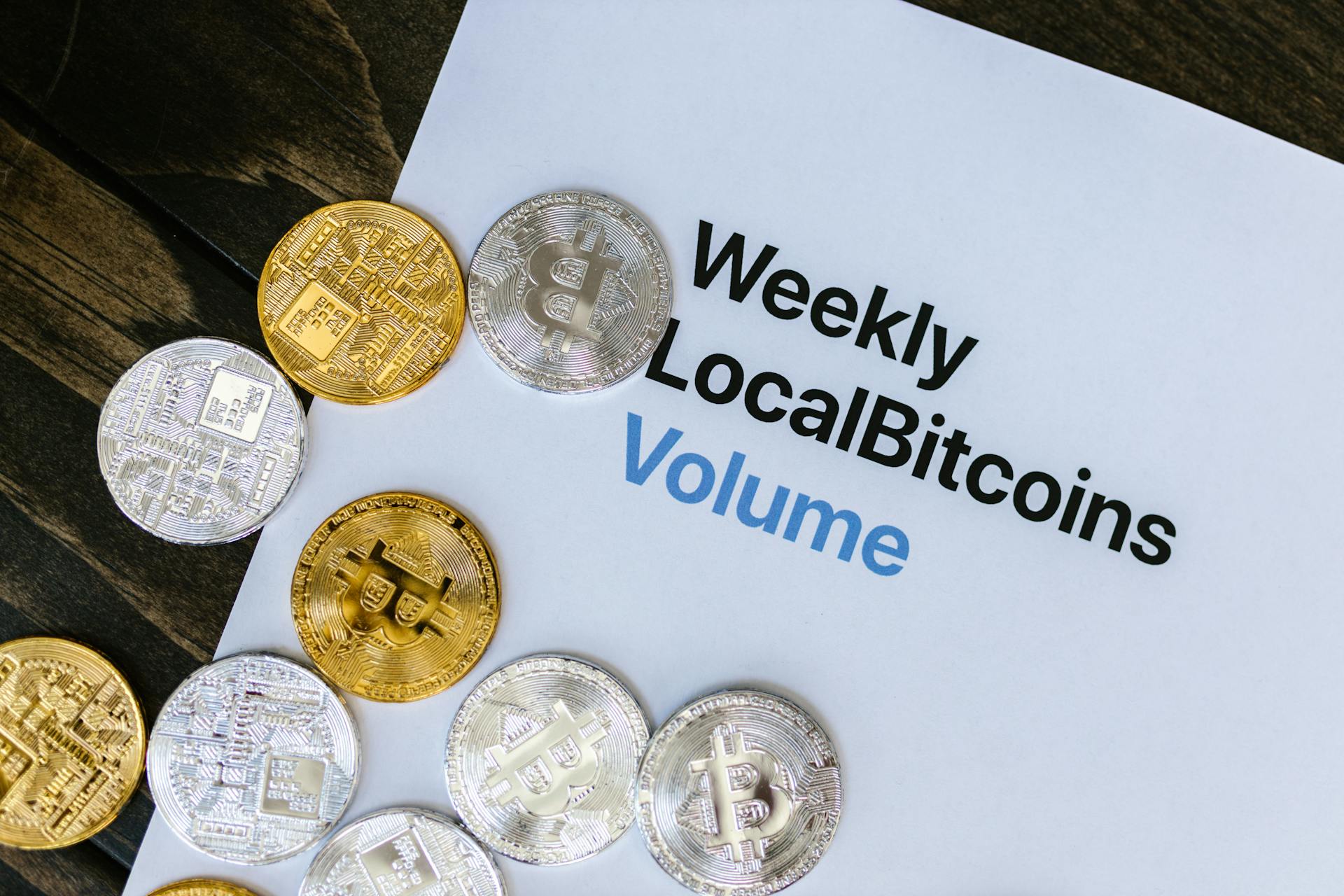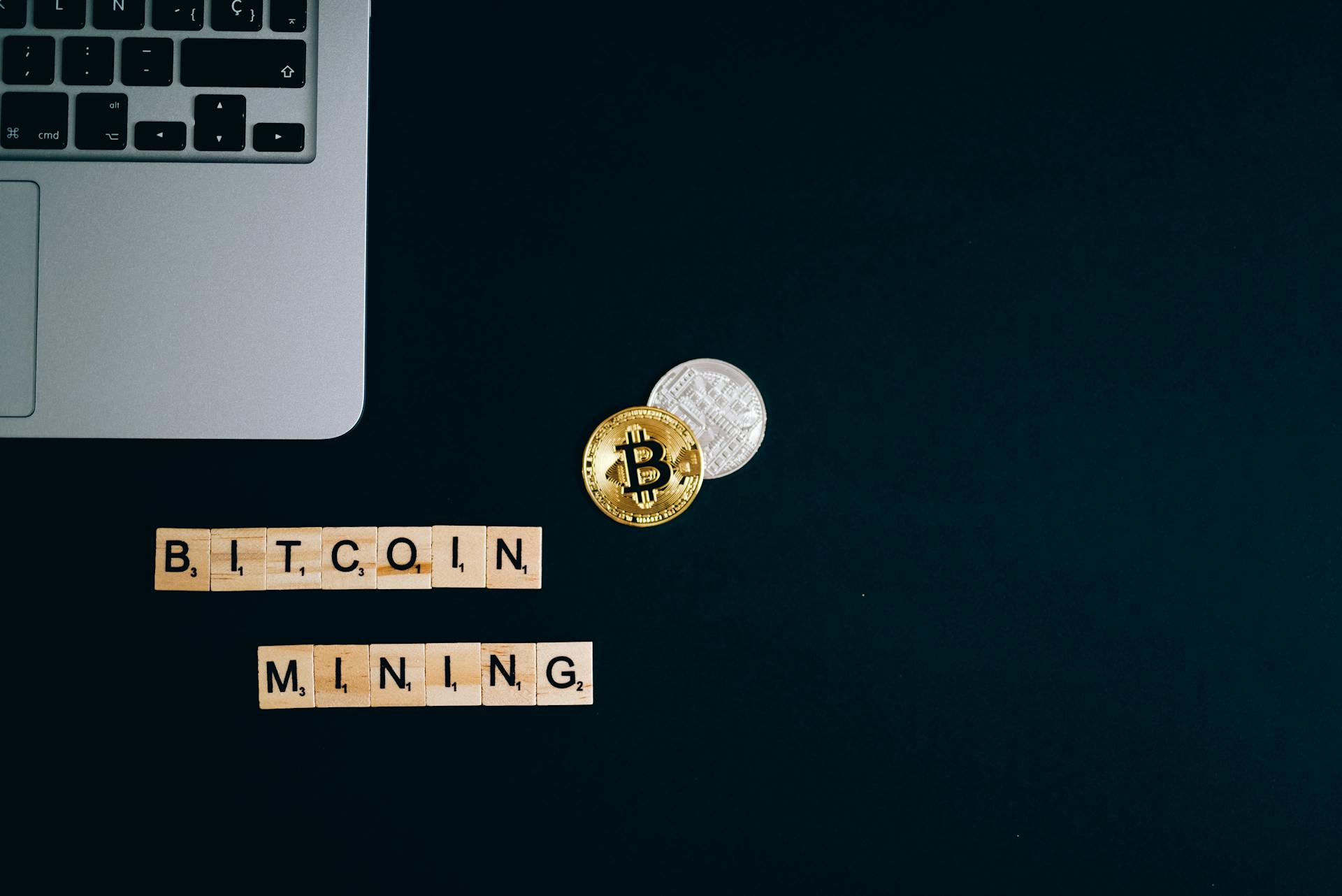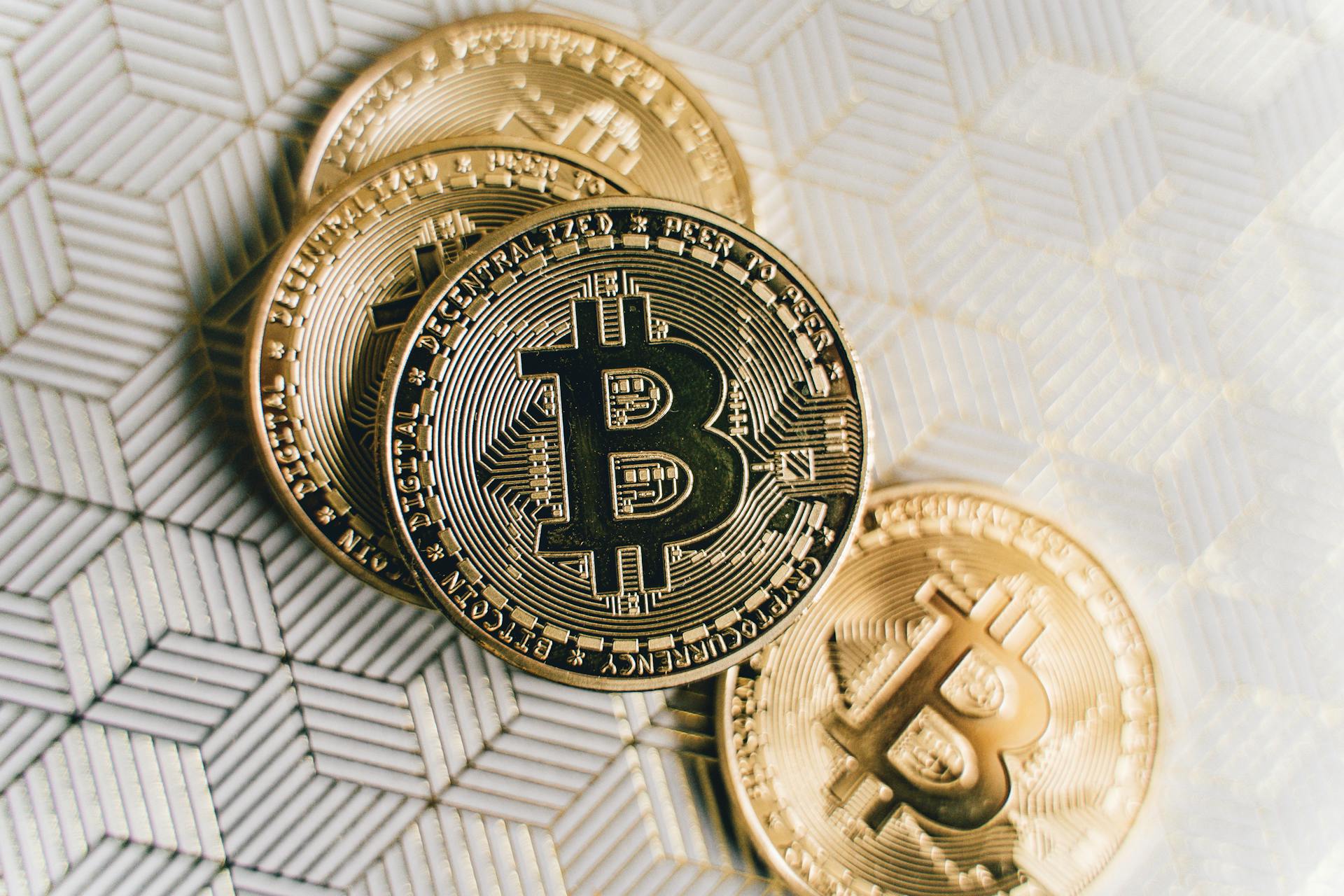
The Bitcoin halving event is a significant milestone that has historically led to a surge in the cryptocurrency's price. This is because the halving reduces the supply of new Bitcoins entering the market, which can drive up demand and, subsequently, the price.
The last two halving events in 2012 and 2016 saw Bitcoin's price increase by 4,000% and 3,700% respectively, within a year of the event. This trend suggests that the halving could be a catalyst for a significant price increase.
Bitcoin's halving is not just a one-time event, but rather a recurring process that occurs every four years. This is because the Bitcoin protocol is designed to reduce the block reward, which is the number of new Bitcoins awarded to miners for solving complex mathematical equations, every 210,000 blocks or approximately four years.
Curious to learn more? Check out: New Coin Market Cap
What Is Halving?
Halving is a process that's built into the computational code of bitcoin, and it's a crucial part of what makes bitcoin unique. It involves the reward for miners getting cut in half every 210,000 formulas (or blocks) solved.
The reward for miners was cut to 25 in the first halving in 2012, then to 12.5 in 2016, and since 2020, it stood at 6.25 tokens. This latest halving has reduced the reward to 3.125 tokens.
The halving is designed to increase the time it takes to reach the 21 million limit of existing bitcoins, and it tends to increase bitcoin's value as a result. The 21 million limit was deliberately capped by bitcoin's creator, Satoshi Nakamoto.
Satoshi Nakamoto determined that roughly every four years, the reward to create new bitcoins would be cut in half, in events known as "halvings." This is a key part of bitcoin's design, intended to make each bitcoin more valuable over time.
Discover more: Bitcoin Halving Cuts in Half the Reward for Mining Bitcoin.
Impact on Bitcoin Price
Bitcoin's price is likely to see a boost after the halving, as it has in the past. Historically, the price has increased by an average of 16% over the 60 days following a halving.
The 2016 halving resulted in a decrease of 6% over the following 60 days, but the price then rallied strongly throughout 2017. This suggests that the price may not always increase immediately after a halving.
Bitcoin's scarcity is a key factor in its potential price increase, as it is a finite currency. With only 21 million bitcoin ever to be mined, the digital asset will increase in scarcity as adoption continues to increase.
In the past, bitcoin's price has increased significantly after a halving. For example, in 2020, the price increased from $8,610 to $11,588 in just three months.
A recent JPMorgan report suggests that the price of bitcoin could fall in the immediate aftermath of the halving, due to the continuing outflow of money from bitcoin investments like ETFs.
However, experts argue that the halving is not the only factor that will push up the price of bitcoin. Other factors, such as increased adoption and speculation, are also at play.
The launch of spot bitcoin exchange-traded funds (ETFs) has led to increased demand for the digital currency. BlackRock's launch of its Bitcoin Spot ETF on the Nasdaq Exchange in January 2024 is a prime example of this.
For more insights, see: Digital Currency Market
The excitement generated around the 2024 halving may also lead to increased awareness and acceptance of the digital currency. This could further drive up the price of bitcoin.
It's worth noting that correlation does not imply causation, especially with such a small sample size. The timing of the price rises may have been purely coincidental, or the rise may have less to do with the actual mechanics of the halvings as opposed to the halvings' narratives.
Miners and Halving
Miners are the backbone of the Bitcoin network, and the halving event will have a significant impact on them. The halving will reduce the reward for mining new blocks from 6.25 bitcoin to 3.125 bitcoin, a significant reduction.
This will make mining unprofitable for many smaller operations, which will likely consolidate or fold. As Matthew Sigel says, "People are going to operate in a marginally profitable environment for as long as they possibly can." Those who can't will probably look to get scooped up by bigger operations.
Additional reading: Why Are Bitcoin Mining Stocks down
The halving will also force miners to prioritize operational efficiency, upgrading to the latest ASICs and optimizing their rigs to minimize electricity usage. This will help them remain profitable, even with the lower block reward.
Some miners may turn to renewable energy sources like solar and geothermal power to mitigate the impact of fluctuating energy costs. This could lead to a decrease in energy consumption, as some miners will no longer be able to compete.
Here's a summary of the halving's impact on miners:
The halving will be a challenging time for miners, but it will also create opportunities for those who can adapt and innovate.
Halving Effects
The halving is designed to make bitcoin more scarce, and ostensibly to push bitcoin's price upward. For the last three halvings, that's exactly what has happened, with bitcoin's price rising significantly in the year that followed.
Bitcoin's price rose from $12.35 to $127 five months after the first halving in November 2012, and from $8,700 to $60,000 between the third halving in May 2020 and March 2021. However, correlation does not imply causation, and it's possible that the timing of these rises was purely coincidental.
The halving itself is unlikely to cause a significant movement in price on the day it happens, with experts saying that the economic impact of the halving has likely already occurred. The day-of tends to be a non-event for the price, according to Matthew Sigel, head of digital assets research at the global investment manager VanEck.
The economic circumstances surrounding the halving are different this time around, with bitcoin having peaked before a halving for the first time. This has led some pessimists to believe that bitcoin's big run has already happened, thanks to the rise of bitcoin ETFs.
Scarcity Economics
The concept of scarcity economics is at the heart of Bitcoin's value proposition. This is where the halving events come in, designed to make bitcoin more scarce over time.
Halving events occur roughly every four years, or after every 210,000 blocks are mined. The first halving happened on November 28, 2012, reducing the reward from 50 BTC to 25 BTC.
The scarcity feature of bitcoin has historically had a positive effect on its price. Following the 2012 halving, Bitcoin's value rose by over 8,000%. Similarly, Bitcoin's value rose by over 1,400% following the 2016 halving and by over 700% after 2020's.
Here are the dates of the past three halving events:
- November 28, 2012: reduced the reward from 50 BTC to 25 BTC.
- July 9, 2016: reduced the reward from 25 BTC to 12.5 BTC.
- May 11, 2020: reduced the reward from 12.5 BTC to 6.25 BTC.
The April 2024 halving is estimated to reduce the reward from 6.25 BTC to 3.125 BTC. This scarcity feature of bitcoin not only adds to its intrigue, historically it has a positive effect on its price.
For another approach, see: Will Tmj Go Away on Its Own?
Past and Future Halvings
The halving of bitcoin's supply has been a significant event in the past, and it's essential to understand how it has affected the price of bitcoin. In each of the three previous halvings, bitcoin went on to rally by three-digit percentage points in the year that followed.
Bitcoin's price rose from $12.35 to $127 five months after the first halving in November 2012. After the second halving in 2016, bitcoin's price doubled to $1,280 within eight months.
The correlation between the halving and the price increase is not a guarantee, as it's possible that the timing of these rises was purely coincidental. It's also possible that bitcoin's rise has less to do with the actual mechanics of the halvings as opposed to the halvings' narratives.
The economic impact of the halving has likely already occurred, with investors buying bitcoin in anticipation of the event. The day of the halving tends to be a non-event for the price, according to Matthew Sigel, head of digital assets research at VanEck.
Here's an interesting read: Next Halving Event Bitcoin
Key Points and Correlations
The halving event is expected to occur on April 19, reducing the mining reward from 6.25 BTC to 3.125 BTC, which could lead to a rise in large-scale mining operations.
Historically, there's a correlation between halving events and subsequent increases in BTC's price. This has happened in the past, with Bitcoin's value rising by over 8,000% after the 2012 halving, and by over 1,400% after the 2016 halving.
Here's an interesting read: When Will Bitcoin Mining End
The stock-to-flow model suggests that a higher ratio of scarcity to new units produced each year corresponds to a higher price. According to this model, Bitcoin's value could rise from approximately $70,000 currently to $130,000+ by 2028.
Here are some key correlations to keep in mind:
- 2012 halving: +8,000% increase in BTC's value
- 2016 halving: +1,400% increase in BTC's value
- 2020 halving: +700% increase in BTC's value
These historical correlations suggest that the upcoming halving event could lead to a significant increase in Bitcoin's value.
Frequently Asked Questions
How long after halving does Bitcoin peak?
According to 10x research, Bitcoin typically peaks around 500 days after a halving event, which is associated with price increases due to reduced supply.
Will bitcoin halving increase the price of other coins?
Bitcoin halving can lead to a price increase in other cryptocurrencies if demand remains steady or rises, creating a ripple effect in the crypto market
Sources
- https://www.npr.org/2024/04/16/1244173751/bitcoin-halving-rally-crypto
- https://www.theguardian.com/technology/2024/apr/19/what-is-bitcoin-halving-price
- https://www.globalxetfs.com/the-bitcoin-halving-a-recurring-decimation-of-supply/
- https://money.com/bitcoins-next-halving-is-near/
- https://time.com/6967414/bitcoin-halving-countdown-event-2024/
Featured Images: pexels.com


